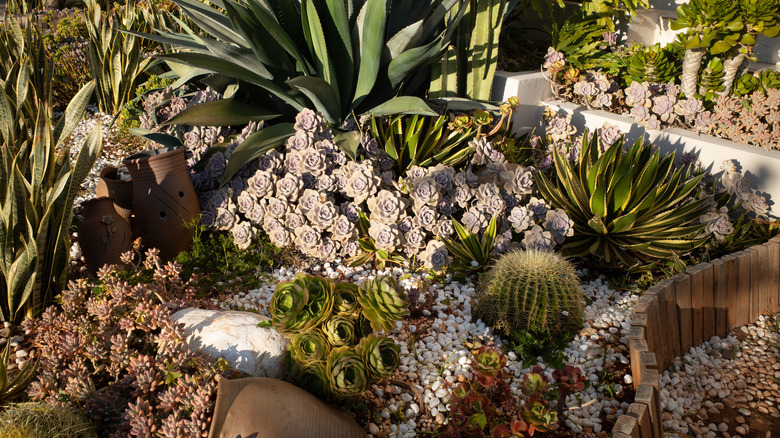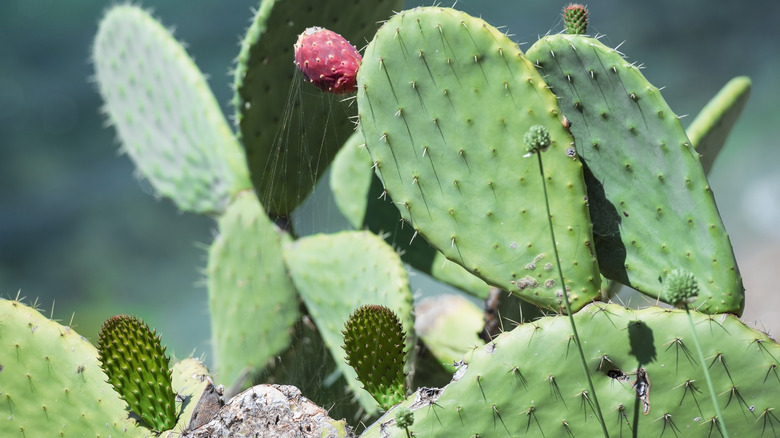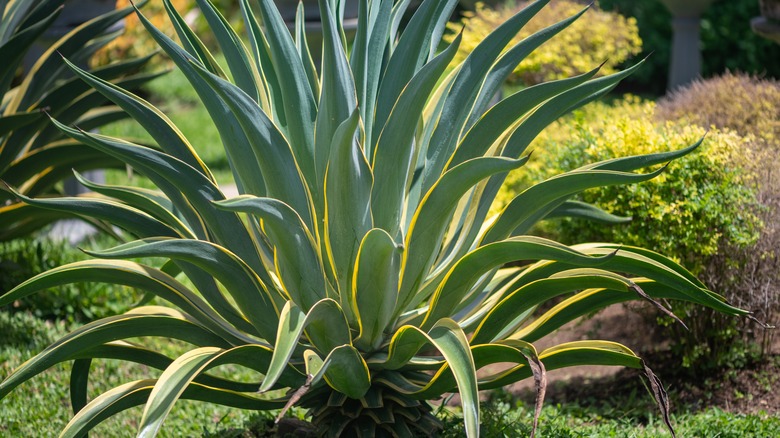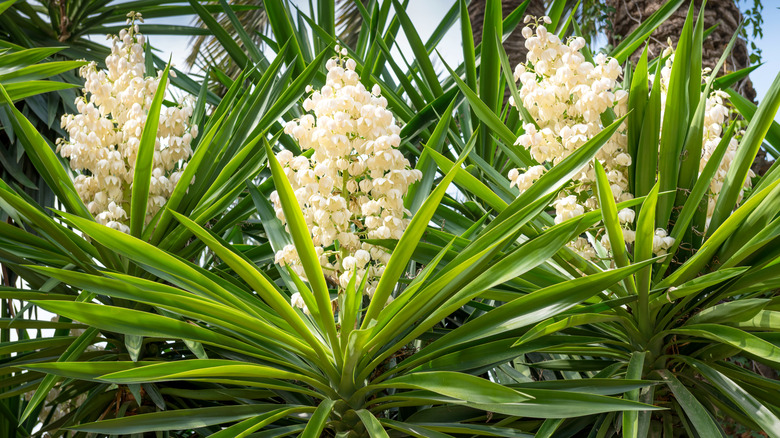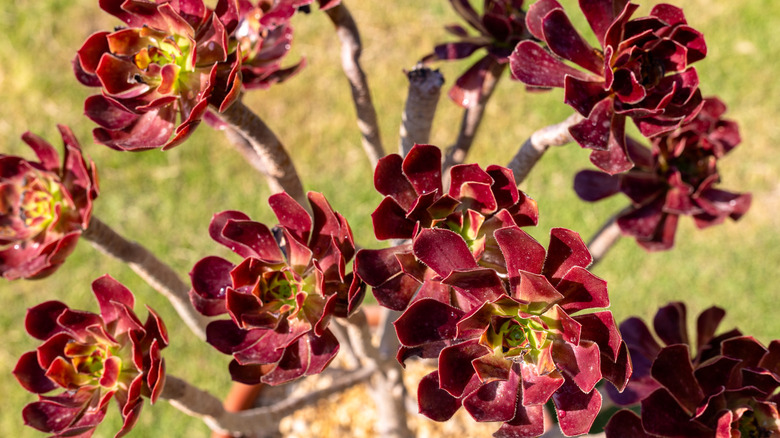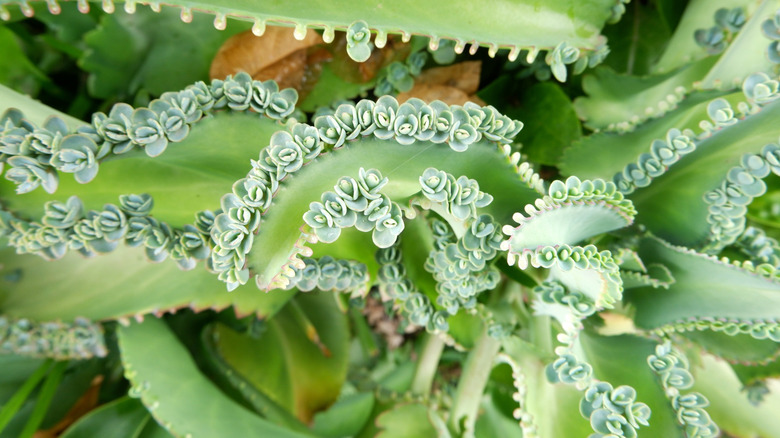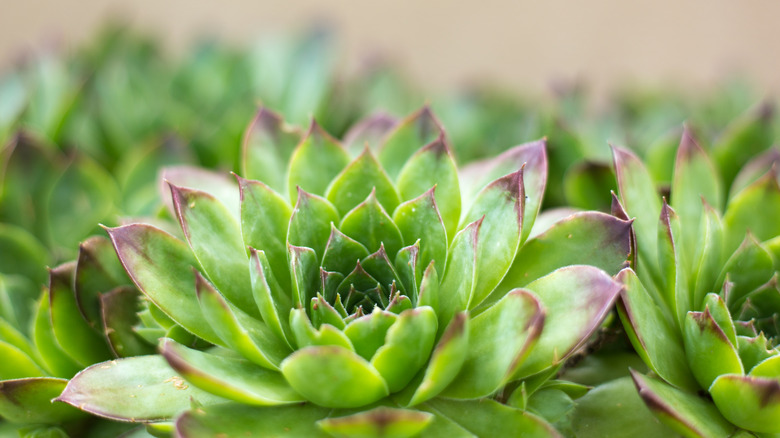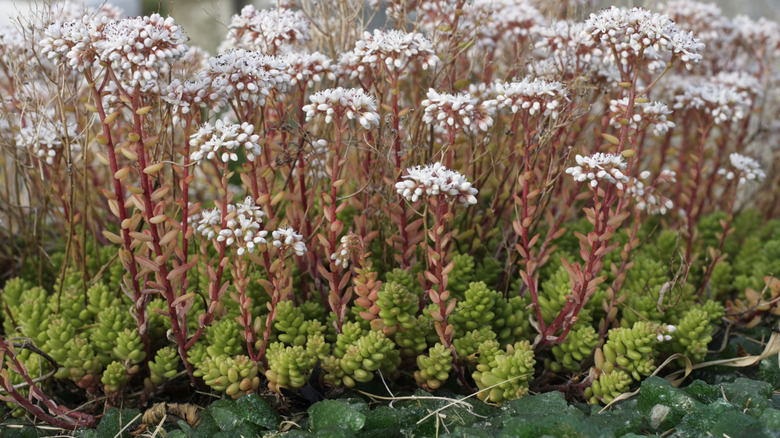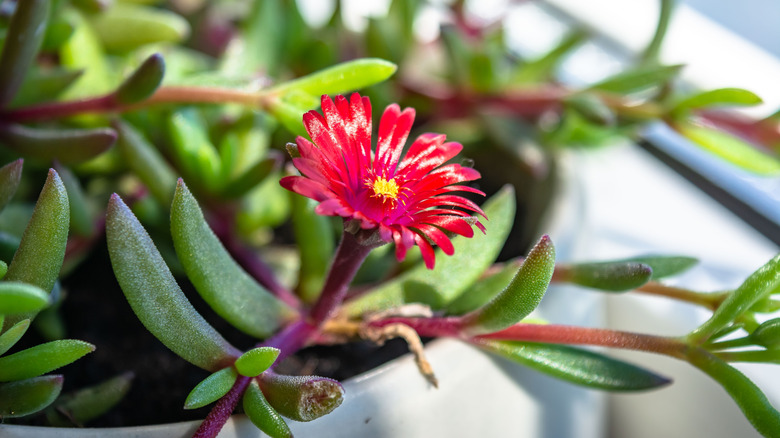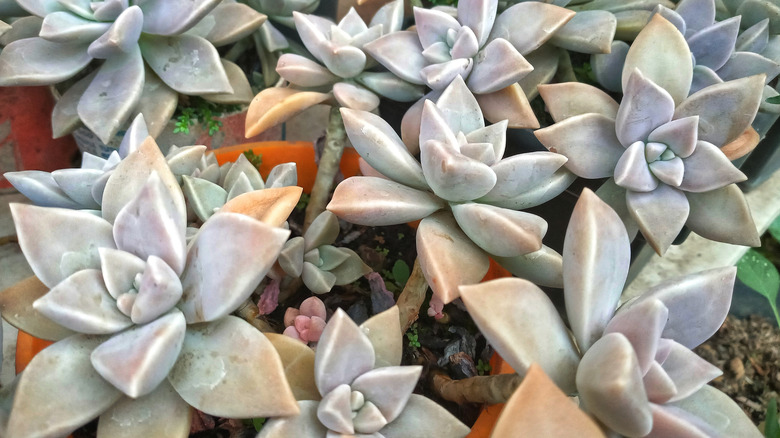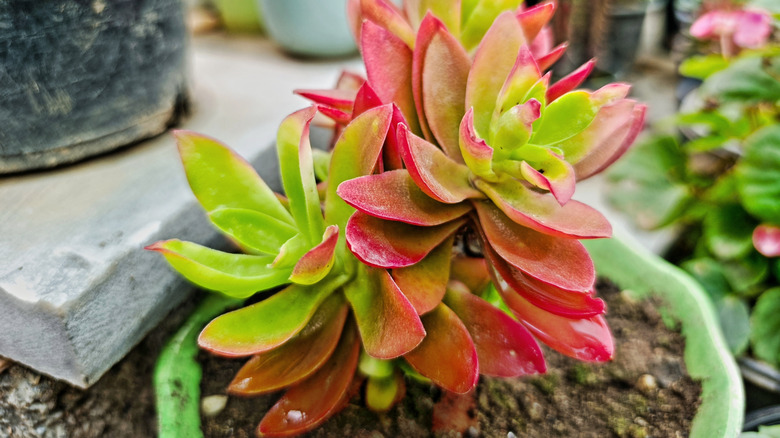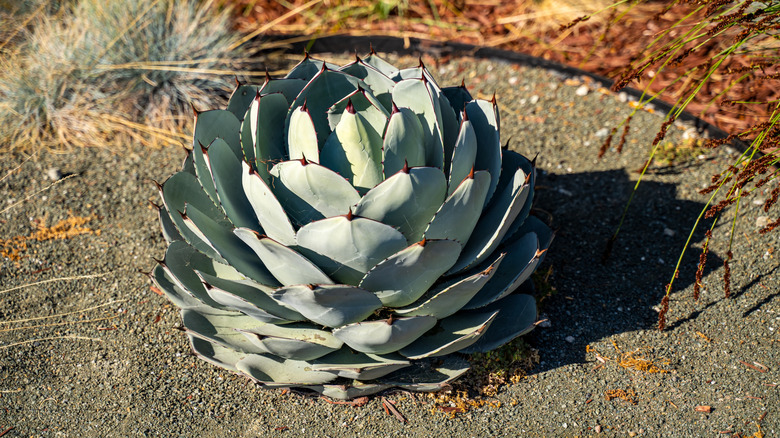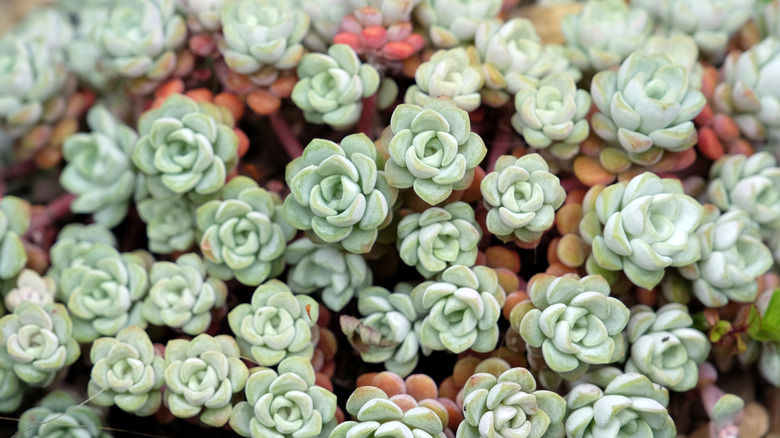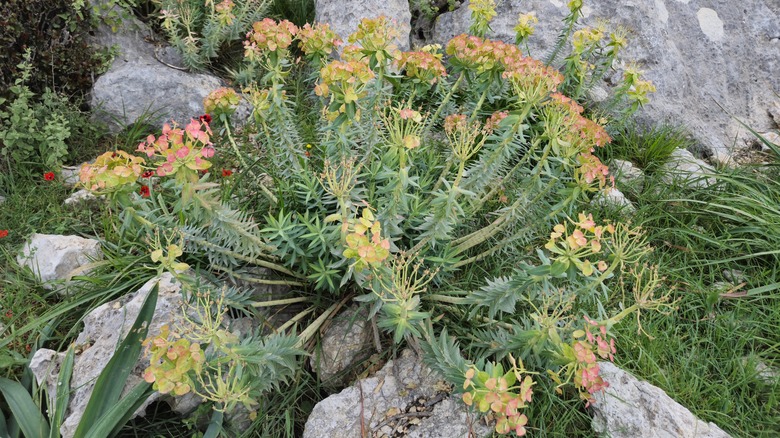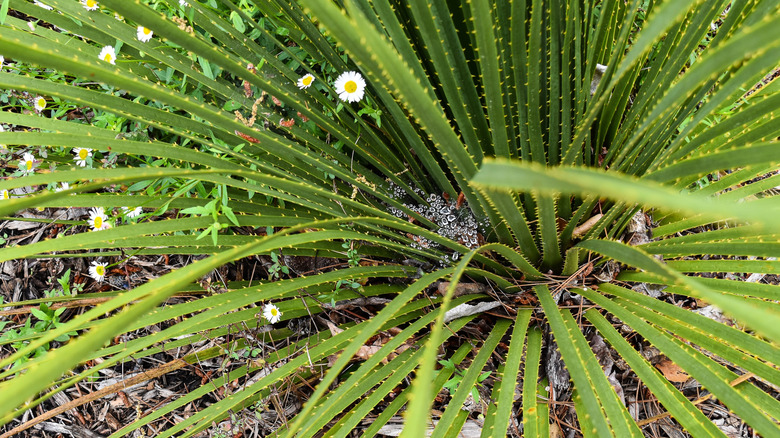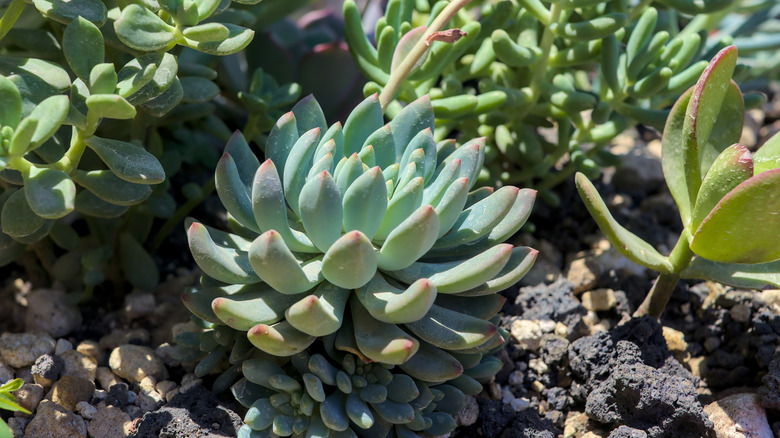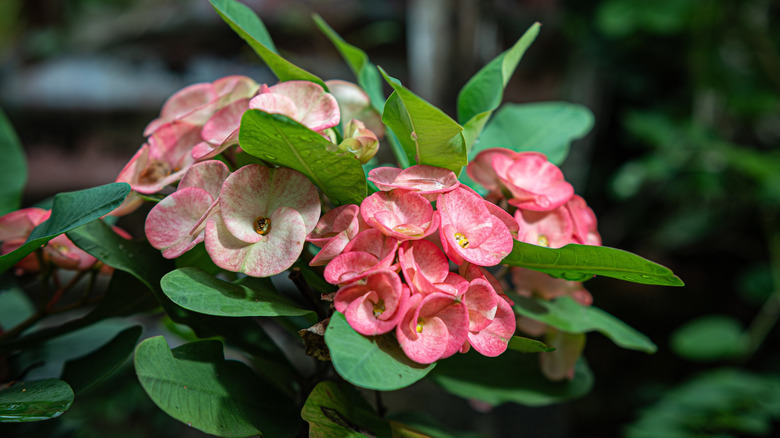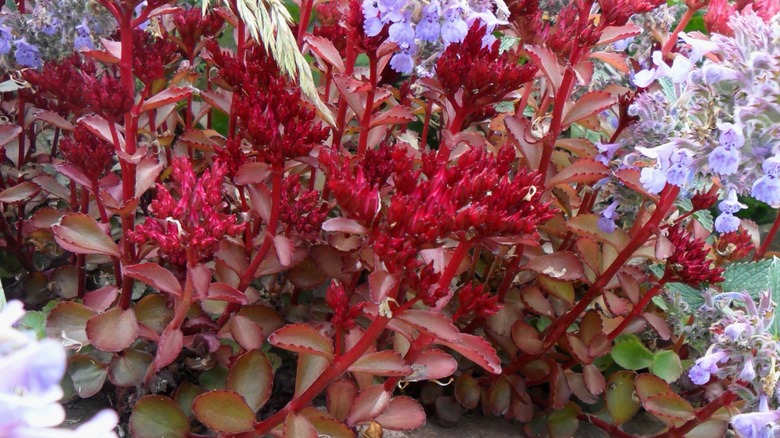17 Succulents That Thrive In Outdoor Environments, And How To Care For Them
Succulents have a way of stealing the spotlight. With their sculptural shapes, vibrant colors, and the ability to thrive in areas where other plants struggle, it's no surprise they're a favorite among both gardeners and non-gardeners. A lot of people think of succulents as little houseplants on a sunny windowsill, but outdoors is really where they shine. In fact, many varieties are naturally built for life under the open sky, where they soak up sunshine, shrug off drought, and add bold texture to landscapes. Succulents are perfect outdoor plants thanks to their adaptability. Whether you're gardening in a desert climate, a coastal region, or even an area that experiences cooler temperatures, there are succulents designed to thrive — and some that are even fast growers.
Succulents are generally happiest in temperatures between 60 and 80 degrees Fahrenheit, though most can tolerate a swing of about 10 degrees warmer or cooler. Certain hardy varieties can even push beyond that range, surviving — and sometimes thriving — even in freezing conditions. From towering agaves that create dramatic focal points to low, carpeting sedums that spill over rocks, there's a succulent for every outdoor space. Some, like prickly pear cacti or yuccas, add height and architectural drama, while others, such as ice plants or hens and chicks, work beautifully as groundcovers. The key is knowing which ones work best in your climate and creating an environment where they'll shine.
Pricklypear cactus
Looking for a rugged, eye-catching succulent that doubles as both ornamental and functional? The pricklypear cactus (Opuntia spp.) has you covered. Its flat, paddle-like pads create an unmissable silhouette in your landscape, while seasonal bursts of brilliant yellow, orange, or pink blooms steal the show. The drought-tolerant plant thrives in USDA Hardiness Zones 3 to 11 and loves soaking up the full sun and needs very little water once it's established.
American century plant
The American century plant (Agave americana) is one of the most dramatic succulents you can grow that will instantly command attention in your landscape. Hardy in zones 8 to 11, the century plant is built for resilience, low-maintenance, unforgettable, and a true statement plant for outdoor spaces. A relatively long lived plant, it only blooms once after about 10 to 25 years, sending up a towering flower stalk. At this point the main plant dies, but you can continue the legacy by saving and replanting the seeds.
Moundlily yucca
Moundlily yucca (Yucca gloriosa) stands out for its dramatic form and year-round ability to thrive. Its rigid, lance-shaped leaves create a bold silhouette, while mature plants produce towering flower stalks covered in showy white blooms that light up the landscape. Hardy in zones 7 to 11, yuccas adapt to sandy grounds and even coastal air, making them a dependable pick for gardens near the shore.
Tree aenium
The tree aenium (Aeonium arboreum) is a pretty succulent that grows into branching stems topped with glossy, rosette-shaped leaves and is winter-hardy in zones 9 to 11. With full sun, its foliage takes on rich burgundy or deep green tones, adding boldness and instant interest to your garden. Give it well-draining soil, moderate watering, and plenty of light, and it will flourish as a living work of art.
Devil's backbone
Devil's Backbone (Kalanchoe daigremontiana) is one of those plants that instantly turns heads. Its tall, zigzagging stems give it an architectural look, while the edges of its leaves sprout tiny plantlets that can drop and grow into new succulents with ease. This quirky beauty is winter hardy in zones 9 to 12. Just give it well-draining soil, occasional watering, and space to spread, and it will reward you with a bold, almost otherworldly presence in your garden.
Hens and chicks
Hens and chicks (Sempervivum tectorum), also known as common houseleek, is a cold-hardy succulent that forms tight rosettes of fleshy leaves. Over time, the main "hen" produces smaller offsets, or "chicks," that cluster around it, creating a lush, ever-expanding mat of texture and color. Hardy in zones 3 to 8, house leeks thrive on neglect, needing little more than good drainage, full sun, and the occasional drink during dry spells. With their low-growing habit and resilience, they bring lasting character to outdoor spaces.
White stonecrop
Whether you have rocky or sandy soil, white stonecrop (Sedum album) can handle them all. In early to midsummer, it produces clusters of delicate white, star-shaped flowers that attract bees and other pollinators. Once established in Zones 3 to 9, they ask for very little in return: six hours of full sun, at least two hours of shade, and enough drainage so the soil can dry out. With minimal water needs, white stonecrops are an adaptable way to weave beauty into tough outdoor spaces.
Ice plant
Ice plant (Delosperma) is a perennial and one of the most vibrant groundcover succulents that dazzles with its jewel-toned blooms. With the ability to spread in dense mats along rock gardens, slopes, and borders, this sun-loving succulent needs good drainage and only light watering. Hardiest in zones 5 to 8, ice plant is a brilliant choice because it's one of the many plants that bloom more than once for a colorful garden year-round.
Ghost plant
Ghost plant (Graptopetalum paraguayense) is a soft-toned succulent with rosettes that color shift, depending on light, from silvery gray to hints of lavender or pink. In zones 9 to 11, this succulent is surprisingly tough despite its delicate features, and flourishes in full sun and sandy soil with only occasional watering. Its trailing growth habit makes it perfect for spilling over containers, rock walls, or hanging baskets.
Campfire
The 'Campfire' (Crassula capitella 'Campfire') succulent is a true showstopper, with its flame-like foliage feature that adds bold, fiery energy to your landscape. Its pointy leaves grow in layered whorls that go from lime green to bright shades of red and orange when basking in full sun. Hardy in zones 9 to 12 and drought-tolerant, this succulent thrives in sandy, well-drained soil with only light watering.
Parry's agave
Parry's agave (Agave parryi) is a compact but extraordinary succulent prized for its symmetry and toughness. Its short, broad blue-gray leaves form tight rosettes edged with sharp spines, creating a bold, sculptural look. Thriving in zones 6 to 10, unlike some larger agaves, this variety stays manageable in size, making it perfect for smaller gardens, rocky borders, or containers. Parry's agave thrives in full sun, well-drained soil, and arid conditions, tolerating both heat and occasional frost.
Broadleaf stonecrop
The broadleaf stonecrop (Sedum spathulifolium) is a low-growing succulent that will add texture and color to your outdoor spaces. Hardy in zones 5 to 9, which means it can handle a wide range of temperatures, the broadleaf stonecrops' spoon-shaped leaves create tight rosettes that can take on silvery blue, green, or even reddish-purple hues, depending on the season and sunlight. This low-maintenance succulent produces yellow little star-shaped blooms to brighten your yard.
Upright myrtle spurge
The upright myrtle spurge (Euphorbia rigida) has exquisite sculptural form that's resilient, with long-lasting color, and is perfect for bringing texture and visual interest to your outdoor landscape. Its upright stems produce pretty clusters of chartreuse-yellow flowers that brighten gardens within zones 7 to 11. Extremely drought-tolerant, this perennial thrives in full sun and well-draining soil, requiring minimum care once it's established.
Texas sotol
Texas sotol (Dasylirion texanum) is an architectural desert plant, featuring long, slender, gray-green leaves that radiate from a central trunk, creating a fountain-like silhouette. Although it thrives in hot, dry conditions, making it perfect for xeriscapes, rock gardens, and drought-tolerant landscapes found in zones 7 to 11, it's also a cold-hardy option. It can handle temperatures that hover around 30 degrees, but not for extended periods of time.
'Blue Elf' sedum
The 'Blue Elf' sedum (Hylotelephium 'Blue Elf') is a compact, low-growing, mat-forming succulent that packs a lot of charm into a small package. Its powdery blue-gray leaves form dense clusters that provide texture all year. This tough little plant thrives in zones 4 to 9, with full sun, soil that drains well, and dry conditions. 'Blue Elf' is easy to take care of and very forgiving if you neglect it from time to time.
Crown of thorns
The crown of thorns (Euphorbia milii) succulent shrub is known for its thorny stems and vibrant, long-lasting flowers. Its clusters of small blooms, ranging from red to pink, yellow, or white, make it a standout addition to your outdoor space. This hardy plant thrives in full sun — especially in zones 10 to 12 — and tolerates heat and drought like a champ. Crown of thorns is also a gorgeous flowering shrub that will keep rats out of your garden.
Sedum spurium 'Voodoo'
Hardy in zones 3 to 8, the 'Voodoo' sedum (Sedum spurium 'Voodoo') is a vibrant groundcover succulent that brings bold color to your garden. Its fleshy, burgundy-red leaves create a dense carpet that looks pretty on its own or as a contrast against lighter plants. Tough and adaptable, 'Voodoo' thrives in full sun, gritty soil, and drier conditions, making it perfect for slopes, rock gardens, or borders around the landscape.
